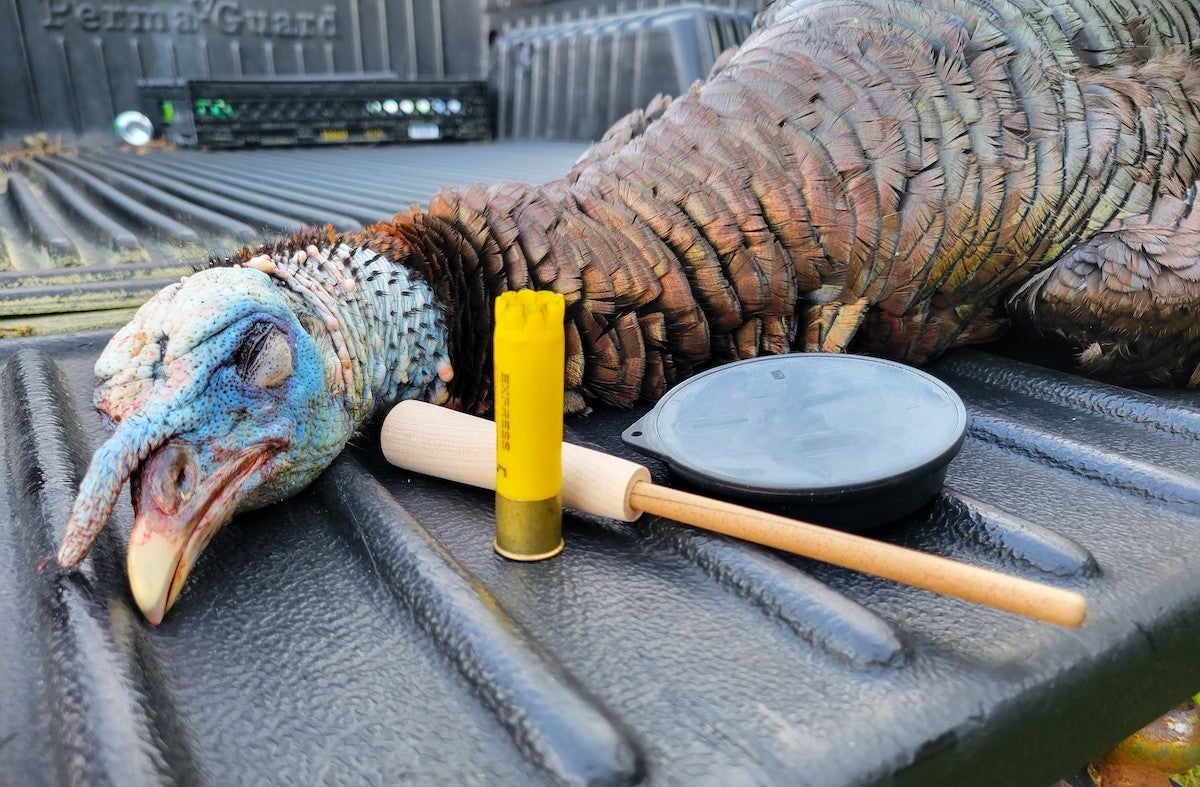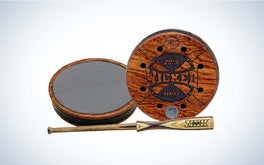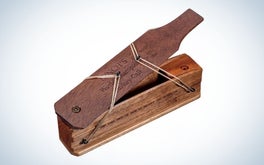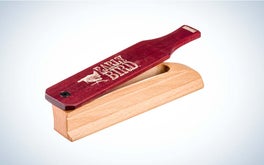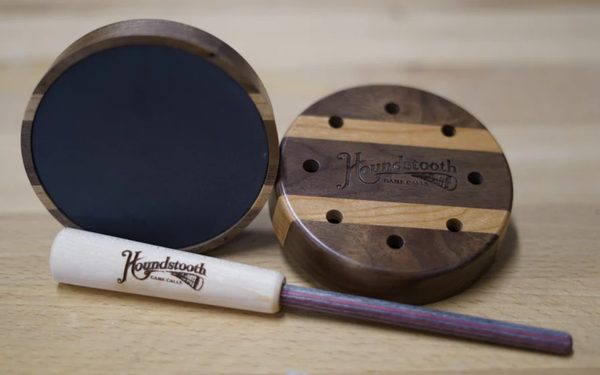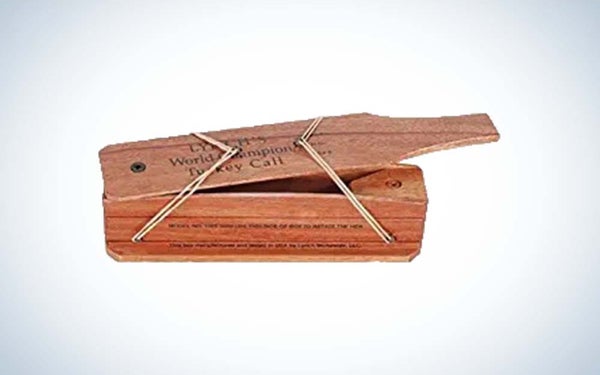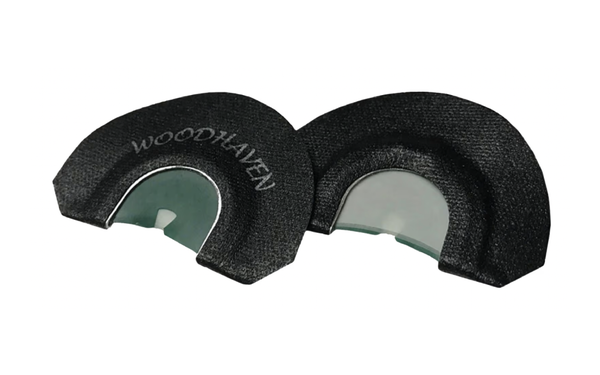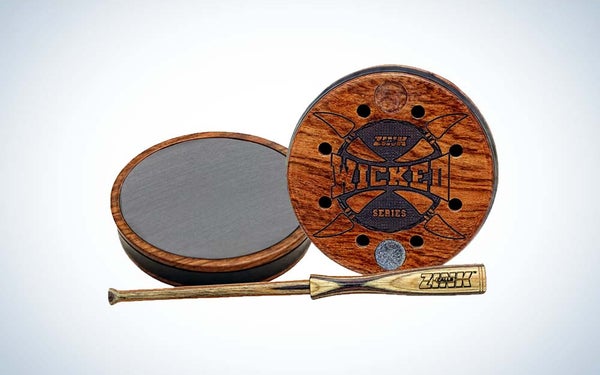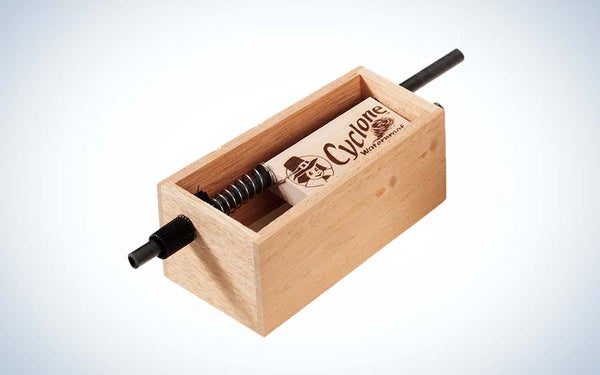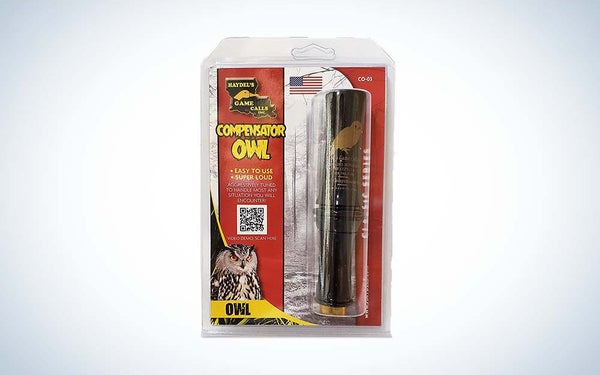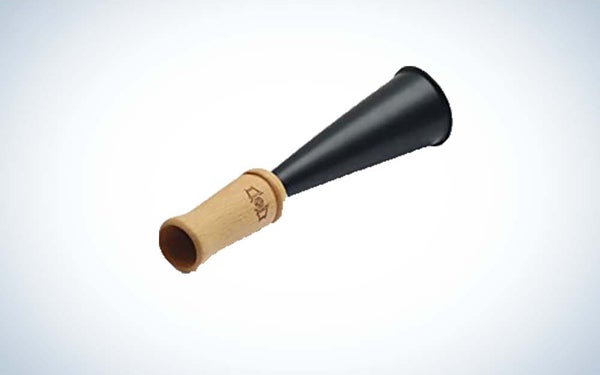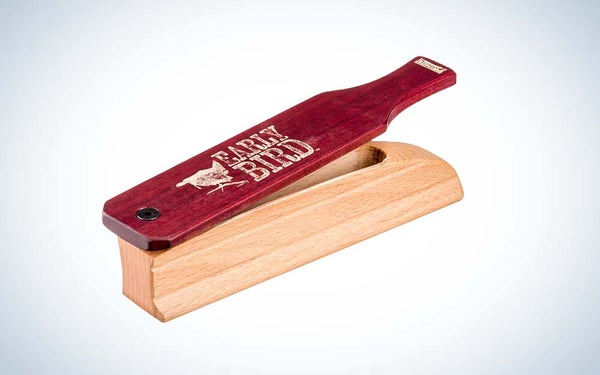We may earn revenue from the products available on this page and participate in affiliate programs. Learn more ›
Like all my turkey hunting gear, my accumulation of turkey calls started a long time ago. I killed my first gobbler, an Ohio bird, back in 1990. My wife, Julie, killed her first, a Washington state Merriams, in 1994. Since then, she’s gone on to kill two Grand Slams. We even killed a slam as a couple in 2005, and have to date, put tags on 109 Spring longbeards.
Bragging? No. But I am awfully proud of her and our field accomplishments together over the past three decades. I provide this background primarily as proof that, as serious turkey hunters, we’ve gone through and currently have a lot of turkey calls. Box calls. Pot calls. Diaphragm calls. You name it, and there’s a good chance that during the last thirty seasons, we’ve played with it at least once.
That all said, I went through my arsenal of calls and hand-picked some of my favorites. Below you will find recommendations on box calls, mouth calls, slate calls, owl calls, and more. These are the best turkey calls to help you bag a gobbler this spring.
The Best Turkey Calls
- Best Turkey Call Overall: Houndstooth Game Calls Dixie Hen Slate
- Best Box Call: Lynch World Champion Box Call
- Best Mouth Call: Woodhaven Custom Calls Ninja Ghost Mouth Call
- Best Slate: Zink Wicked Series Slate
- Best Push Button Call: Quaker Boy ‘Cyclone’ Easy Yelper
- Best Owl Hooter: Haydel’s CO-03 Compensator Owl Call
- Best Locator: Hunter’s Specialties/Drury Outdoors Signature Howler
- Best Budget: Primos Early Bird Box Call
How We Picked The Best Turkey Calls
These are most of our go-to calls, the ones we reach for first when we step into the field each spring. We have plenty of hands-on experience with all of them. Our working turkey vests have changed over the years as old calls wear out and new ones take their coveted spots.

Here’s how we decide which calls will ride with us into the turkey woods each season:
- Personal Experience: These are the calls we have used or used for years. If a call spends more than a single season in our vest—or more than a single hunt, for that matter—it has something going for it.
- Ease of Use: Turkey hunting is hard enough without running a call requiring a genius-level IQ to operate. We like simple-to-use calls, and those are the ones that make the cut time and time again. However, we don’t let simplicity outweigh realistic sound. This line-up affords both.
- Sound: The best turkey calls, regardless of price tag, sound like real-life birds. Each call on this list will produce life-like sounds, although some may require more practice. The common denominator here is affordable calls from respected companies that can sound just like a mama (or soon-to-be) bird.
Best Turkey Call Overall: Houndstooth Game Calls Dixie Hen Slate
Pros
- Durable, laminated design
- Suitable for long-range and close-range calling
- Easy to use
- Produces a wide range of realistic tones
Cons
- Requires two hands to operate
Houndstooth Game Calls is a promising young company out of Alabama that knows more than a thing or two about hunting turkeys. Their Dixie Henpot call is an old-school, traditional-style pot call that produces an uncommonly good sound.
It produces lyrical clucks and soft, inviting clucks yet has enough pluck to get cuts and cackles loud enough to bust through thick, early morning fog.
The two-tone walnut and cherry finish also makes this thing quite a looker. You’ll want to show this thing off like a fine violin, but not just because it’s pretty. In practiced hands, it can produce some downright beautiful music.
This call comes with a two-piece Dymondwood striker. It is preconditioned and works like a dream straight out of the package.
Specs
- Type: Pot call
- Material: Walnut and cherry pan, slate over glass surface, Dymondwood striker
Best Box Call: Lynch World Champion Box Call
Pros
- Extremely user-friendly
- Straight grain mahogany gives excellent mellow tones
- Made by a company with a long-standing reputation for excellence
- Versatile volume range
Cons
- Rubber bands can break
- Wood has limitations in wet weather
The Lynch World Champion Box Call is a great-sounding call that’s easy to use, costs under $45, and looks like a custom-crafted instrument. It’s hard to beat the realism of this wooden call and the reputation of Lynch World Champion calls. It’s made from straight grain mahogany, cut and assembled to precise tolerances, and then tweaked to make it sound just right before it leaves the plant. I’m confident it can strike up a gobbler right out of the box, although I don’t recommend doing that. Sand the lid and rails, chalk it up, and then practice before going afield. You won’t be disappointed.
Specs
- Type: Box call
- Material: Mahogany
Best Mouth Call: Woodhaven Custom Calls Ninja Ghost Mouth Call
Pros
- Incredibly versatile
- Good volume
- Sounds like a real hen
- Great for beginners
Cons
- Experts may prefer something more complex
I tend to collect mouth calls the same way some girls hoard shoes. And because I love them all for different reasons, it’s almost impossible to narrow that stockpile to an all-time favorite. I’m a firm believer that you should carry at least a dozen different diaphragm calls in your turkey vest. That’s why I’ve narrowed this category down to a trio of calls.
Woodhaven’s Ninja 3-Pack includes the company’s popular Ninja Ghost, Ninja V, and Ninja Venom mouth calls. Each one is a straightforward triple-reed call that is easy for even beginners to produce realistic turkey tones.
Each call is made from hand-stretched proph (that’s turkey-call speak for the type of ultra-thin thin latex material used to make condoms) and thicker latex to produce three different turkey sounds.
The Ninja Ghost features a small ghost-style cut in the middle of the top reed that produces crisp yelps, clucks, and kee-kees with minimal rasp. If you want realistic yelps that start with a clear front note followed by a nasal rasp, you can reach for the Ninja Venom, which has a unique cut that is easy for newbies to control. The Ninja V rounds out the threesome. Featuring a tired-and-true V cut, this diaphragm call can produce some seriously loud cuts that work wonders for coaxing in tough toms from a distance. You can also dial this one back to produce soft, gentle purrs once he comes strutting into range.
Specs
- Type: Mouth call
- Material: Latex
Best Slate: Zink Wicked Series Slate
Pros
- Attractive visually
- Great turkey sounds
- Built-in striker tip conditioner
- The rubberized grip around the circumference makes holding the call easy
Cons
- Expensive
- Slate may not be as loud as glass or crystal
I shot my first specklebelly goose with Fred Zink in northern North Dakota back in the early 1990s, and I’ve been a fan of the boy from Buckeye Land ever since. A champion goose caller and waterfowl call designer, Zink built his reputation on making duck and goose calls. Turns out, he’s just as good at making turkey calls.
I love the rubber ring around the edge of Zink’s pot call because this makes gripping the Wicked Series with my fingertips a sure thing. And this grip helps me get as much sound clarity and volume out of the instrument as possible.
You can also flip this call over to use a second calling surface. Dubbed “The Sweet Spot,” this added bonus is a great way to make those delicate, super soft, close-range calls.
It’s a plain and pretty call, with no skulls or bones or devil tongues. And it sounds like a million bucks. Soft and close; loud and far. This one does it all. However, I’m a fan of the flared-tip strikers, but swapping it for a Mad Calls purple heart/acrylic stick—my favorite— is pretty simple.
Specs
- Type: Pot call
- Material: Brazilian cherry pan, slate surface, Dymondwood striker
Best Push Button Call: Quaker Boy ‘Cyclone’ Easy Yelper
Pros
- Very easy to use
- Adjustable
- One-handed operation
- Affordable
Cons
- Lacks the volume of larger box calls
To me, there’s just something missing with a push-button turkey yelper. True, they’re undeniably easy to use, and some, like the Cyclone, sound pretty darn good. I’ve just always been a glass and diaphragm guy. However, you’ll get no argument from me about Quaker Boy’s Cyclone. Push a button, and a good hen yelp emerges. Push it slowly, and the yelp becomes a purr. Lay your thumb on the maple lid, and the purr turns into a whine. With practice, cuts and cackles are on the menu too. As for the so-called clucker button, a light tap, and you’re clucking like an old mama turkey. Is a push-button like the Cyclone for everyone? No, but it is for anyone looking for something easy and a little different.
Specs:
- Type: Push button friction call
- Material: Mahogany sides, maple striker
Best Owl Hooter: Haydel’s CO-03 Compensator Owl Call
Pros
- Easy to use
- No hand manipulation (back pressure) needed
- Compact
- Good volume
Cons
- Not as mellow as a wooden owl hooter
One of the best locator calls on the market, this owl hooter is easy to blow and produces shock gobbles without problem. With the Compensator Owl Hooter, you just need to get the rhythm down—Who cooks for you? Who cooks for you all?—and the call essentially does the rest. The CO-03 has all the volume necessary to carry the distance and, more importantly, cut through any wind, reaching out and touching those old roosted gobblers. Built from a tough polycarbonate, the Compensator should last many seasons, regardless of the rigors.
Specs:
- Type: Locator call
- Material: Polycarbonate plastic
Best Locator: Hunter’s Specialties/Drury Outdoors Signature Howler
Pros
- Incredible distance
- High pitch makes even tight-lipped longbeards gobble
- Simple to use
Cons
- May incite a riot among your local coyote population
Since my first gobbler, I’ve used somewhere in the neighborhood of 1.529 million locator calls. Peacock screams. Goose calls. Train whistles. Cow bawls. Slamming doors. Nothing instigated gobblers into sounding off to the degree that Mark Allen Drury’s (MAD) coyote howler has. Nothing. I’ve packed one of these—first generation—coyote howlers for over 30 years now, and can’t tell you how many turkeys have gobbled at this thing. It works.
This is as simple as it gets, and you damn near can’t screw it up. The pitch and volume? Off the charts, if that’s what you’re looking for. It gets on every last nerve—trust me—but that’s why it works so well. It’s no work of art, but doesn’t matter because it’s the sound you’re looking for. Not good looks.
Specs:
- Type: Locator call
- Material: Hardwood body with plastic horn
Best Budget: Primos Early Bird Box Call
Pros
- Great volume when needed; quiet when necessary
- Weighted paddle helps cut down on lid bounce
- Affordable
Cons
- Wood doesn’t do well in the rain
Will Primos’ name has become synonymous with some of the finest hunting calls available—and at prices that won’t put a serious hurting on your wallet. For right around $30, the Early Bird Box Call brings great sound and versatility to the table. It’s easy to use, and the combination of the oak body and purple heart lid makes a wide range of turkey sounds and volumes possible right out of the package. The heavier weighted paddle is a nice touch for easy control and feel. And, if it matters, the Early Bird doesn’t look too shabby, either.
Specs
- Type: Box call
- Material: Oak body, purpleheart wood lid
What To Look for in a Turkey Call
There are three main criteria for choosing a turkey call—Physical ability, skill level, and personal preference. After that, there on some secondary considerations like price point and application. Remember these three things when buying your next turkey call:
Physical Ability
There may be physical considerations in play when it comes to choosing what type or style of turkey call you to decide upon. You might able to use one call well, and another not so much. Everyone is different. My father is a perfect example. As a full denture wearer, he can’t make a roof of the mouth diaphragm call do what it’s supposed to do. Nor can he make a pot style call work due to a slight neurological malfunction. But he can use a box call. Proof that there’s a call for everyone.
Skill Level
Of the three major categories of turkey calls – box calls, pot style calls (slate/glass/aluminum), and diaphragm calls – it’s the mouth calls that often prove the most troublesome for folks, particularly new turkey hunters/callers. There’s no question there’s a learning curve involved with diaphragms, and my best advice for someone wanting to learn is to stick with it. Watch instructional videos. And do not make it harder than it needs to be.
The box call is responsible for the demise of more gobblers every Spring than all the other types of calls combined. Why? Because it’s simple to operate and it sounds good. Now, I’m not implying there’s no learning curve associated with the box call—because there is—but for the novice, it’s most certainly the way to go.
My personal favorite? The pot style call, specifically, a glass call or the slightly more mellow glass-over-slate. I think it falls right in the middle between the box call and the diaphragm in terms of the learning curve. However, if you can hold and operate an ordinary lead pencil, you have the skills necessary to successfully operate a pot style call. Sure, there’s a little more involved, but not much.
Personal Preference
This might seem obvious, but sometimes you like a call, well, just simply because you like it. And that’s ok. I have my own favorites. I like the way they sound. The way they look. The way they feel. After you test out a bunch of calls, you’ll get a feel for what you like and what you don’t like.
FAQs
Q: Which is better: a glass or slate turkey call?
This question comes down to personal preference. Both are pot style calls used in conjunction with a peg, aka striker, and both are operated in the same fashion. A softer material than glass, slate calls will generally have a more mellow sound than will the harder glass, the latter often producing a clear, crisp tone of mid- to higher volume. As for the better of the two calls? The answer is really neither, as both are excellent choices for all styles of turkey hunting.
Q: Will a slate call work in the rain?
Maybe. A slate call can be used in the rain or when wet, if it’s played with a non-wooden striker made of carbon, acrylic plastic, or fiberglass. Why? Because wood and water generally don’t mix well, and such is the case here. If you’re hunting in wet conditions, it is best to choose a glass, glass-over-slate, or crystal (a hard glass) calling surface and match it with a non-wood striker.
Q: What is the loudest turkey call?
All three styles of turkey calls—box calls, pot calls, and diaphragms—can produce high volume sounds. However, the higher a call goes in volume, the less realistic or natural the calls become. Most would agree a box call can achieve the highest volume without a loss in realism, followed by the pot style calls, and then mouth calls.
Q: How long do turkey mouth calls last?
Typically, I’ll get one season out of my mouth calls if I take care of them. That means drying them, separating the reeds with a toothpick post-hunt, and storing them in a multi-call case in the refrigerator. Mouth calls, though, are relatively inexpensive, so if I have to replace one or more each Sprin, which I do, so be it.
Q: What is the easiest turkey call type to use?
If you can rub two sticks together, you can operate a box call, which is probably the easiest of the three call styles to use. However, I’m of the mind anyone can make sounds with all three types of calls. It’s knowing what the sounds mean to that old gobbler. That’s the challenging part of the equation. That said, box calls are the hands-down winner in terms of ease of use.
Q: What is the most difficult turkey call type to use?
A mouth call. The trick with a mouth call is to find one that fits properly, one that seals as it should, allowing you to present air between your tongue and the call positioned in the roof of your mouth. Practice makes perfect.
What Is the Best Turkey Call?
We firmly believe the Houndstooth Game Calls Dixie Hen Slate is one of the best turkey calls ever to hit the turkey woods. It produces some of the richest, clearest real-to-life tones we’ve ever heard from anything that wasn’t a living, breathing hen bird. However, turkey calls are a lot like musical instruments; they are only as good as the musician behind them. Whether you prefer a mouth call or a scratch box, it’s a good idea to practice before you hit the woods this spring.
- Best Turkey Call Overall: Houndstooth Game Calls Dixie Hen Slate
- Best Box Call: Lynch World Champion Box Call
- Best Mouth Call: Woodhaven Custom Calls Ninja Ghost Mouth Call
- Best Slate: Zink Wicked Series Slate
- Best Push Button Call: Quaker Boy ‘Cyclone’ Easy Yelper
- Best Owl Hooter: Haydel’s CO-03 Compensator Owl Call
- Best Locator: Hunter’s Specialties/Drury Outdoors Signature Howler
- Best Budget: Primos Early Bird Box Call
Why Trust Us
For more than 125 years, Field & Stream has been providing readers with honest and authentic coverage of outdoor gear. Our writers and editors eat, sleep, and breathe the outdoors, and that passion comes through in our product reviews. You can count on F&S to keep you up to date on the best new gear. And when we write about a product—whether it’s a bass lure or a backpack—we cover the good and the bad, so you know exactly what to expect before you decide to make a purchase.
